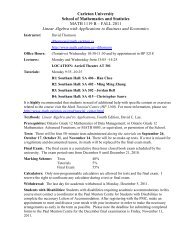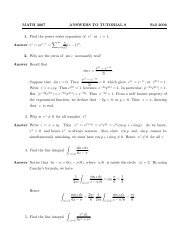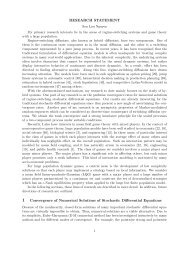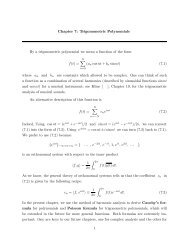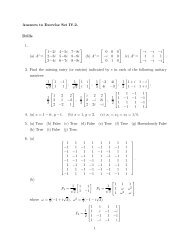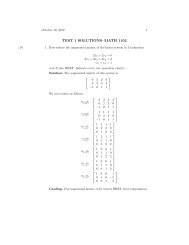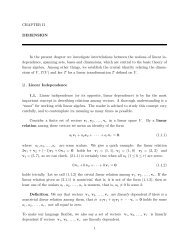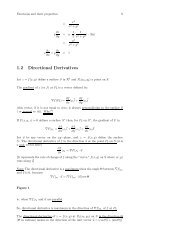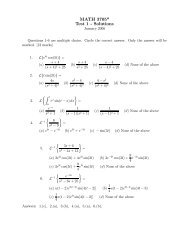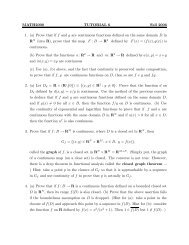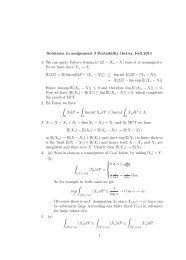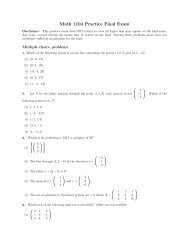MATH 3007A Test 3 Solutions
MATH 3007A Test 3 Solutions
MATH 3007A Test 3 Solutions
You also want an ePaper? Increase the reach of your titles
YUMPU automatically turns print PDFs into web optimized ePapers that Google loves.
[Marks]<br />
<strong>MATH</strong> <strong>3007A</strong><br />
<strong>Test</strong> 3 <strong>Solutions</strong><br />
November 4, 2011<br />
Note: Unless stated otherwise, you may employ any theorem given in class in order to<br />
evaluate integrals.<br />
1. Let γ1(t) =2eπit [6] <br />
, 0 ≤ t ≤ 1, and γ2(t) =2− 4t, 0 ≤ t ≤ 1. Is it necessarily true that<br />
f(z) dz = f(z) dz? Justify your answer. (You need not evaluate these integrals.)<br />
[3]<br />
[3]<br />
[3]<br />
[4]<br />
γ1<br />
γ2<br />
(a) f(z) = 1<br />
(b) f(z) =<br />
z − i<br />
1<br />
z +3<br />
Solution:<br />
(a) f(z) = 1<br />
z − i is analytic on A = C \{i}. Sinceγ1is not homotopic to γ2 in A, the<br />
integrals need not be equal.<br />
(b) f(z) = 1<br />
z +3 is analytic on A = C \{−3}. Since γ1 is homotopic to γ2 in A, the<br />
integrals are equal by the deformation theorem.<br />
<br />
e<br />
2. Evaluate<br />
z<br />
dz, where the image of γ is the square with vertices at (1, 1), (−1, 1),<br />
γ<br />
z 2 − 4<br />
(−1, −1) and (1, −1), traversed counterclockwise, once.<br />
Solution:<br />
f(z) = ez<br />
z2 is analytic on A = C \{±2}. Sinceγis homotopic to a point in A, the<br />
− 4<br />
integral is 0 by Cauchy’s theorem (homotopy version).<br />
3. Let f(z) = 1<br />
z − 2 .<br />
<br />
(a) Evaluate f(z) dz, whereγ1(t) =e2πit , 0 ≤ t ≤ 1.<br />
γ1<br />
Solution:<br />
f is analytic on A = C \{2}. Sinceγis homotopic to a point in A, the integral<br />
is 0 by Cauchy’s theorem (homotopy version).<br />
<br />
(b) Evaluate f(z) dz, whereγ2(t) =2+e2πit , 0 ≤ t ≤ 1.<br />
γ2<br />
Solution:<br />
<br />
f(z) dz =<br />
γ2<br />
<br />
4. Evaluate<br />
γ<br />
1<br />
0<br />
1<br />
e 2πit 2πie2πit =2πi.<br />
f(z) dz, wheref(z) =e z − sin(z) andγ(t) =2t + i sin(4πt), 0 ≤ t ≤ 1.<br />
Solution:<br />
f is continuous and has an analytic antiderivative F (z) =ez +cos(z) onA = C hence,<br />
by the fundamental theorem,<br />
f(z) dz = F (γ(1)) − F (γ(0)) = F (2) − F (0) = e 2 +cos(2)−2. γ
[4]<br />
[4]<br />
[3]<br />
Alternatively, γ is homotopic to γ1, whereγ1(t) =2t, 0≤ t ≤ 1, hence, by the defor-<br />
<br />
1 <br />
2t 2<br />
mation theorem, f(z) dz = f(z) dz = e − sin(2t) · 2 dt = e +cos(2)−2. γ<br />
γ1<br />
5. Let C denote the straight line from (0, 0) to (1, 1), followed by the straight line from<br />
(1, 1) to (1, 0).<br />
(a) Parametrize C, i.e., determine the curve γ with image C.<br />
Solution:<br />
γ = γ1 ∪ γ2, whereγ1(t) =t + it, 0≤ t ≤ 1, and γ2(t) =1+i(1 − t), 0 ≤ t ≤ 1.<br />
<br />
(b) Evaluate zdz.<br />
γ<br />
γ<br />
Solution:<br />
1<br />
1<br />
zdz= zdz+ zdz= (t + it)(1 + i) dt + [1 + i(1 − t)](−i) dt<br />
γ<br />
γ1<br />
γ2<br />
0<br />
0<br />
1 1<br />
<br />
1<br />
= 2it dt + 1 − t − idt= i + − i =<br />
0<br />
0<br />
2 1<br />
2 .<br />
Alternatively, f is analytic on A = C,andγis homotopic to γ3 <br />
on A, whereγ3(t)<br />
<br />
=<br />
1<br />
t, 0≤ t ≤ 1, hence, by the deformation theorem, zdz= zdz= tdt=<br />
γ<br />
γ3<br />
0<br />
1<br />
2 .<br />
Alternatively, f(z) =z is continuous and has an analytic antiderivative F (z) = 1<br />
2 z2<br />
<br />
on A = C, hence, by the fundamental theorem, zdz= F (γ(1)) − F (γ(0)) =<br />
γ<br />
1<br />
2 .<br />
<br />
1<br />
6. Evaluate dz, where the image of γ is the square with vertices at (0, 0), (1, 1),<br />
γ z − 1<br />
(2, 0) and (1, −1), traversed clockwise, once.<br />
Solution:<br />
f is analytic on A = C \{1}, andγis homotopic to γ1 on A, whereγ1(t) =1+e−2πit ,<br />
0<br />
<br />
≤ t ≤ 1, hence,<br />
<br />
by the deformation<br />
<br />
theorem,<br />
1<br />
1<br />
1<br />
1<br />
dz = dz =<br />
z − 1 z − 1 e−2πit(−2πie−2πit ) dt = −2πi.<br />
γ1<br />
0<br />
0<br />
2



